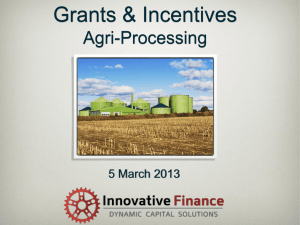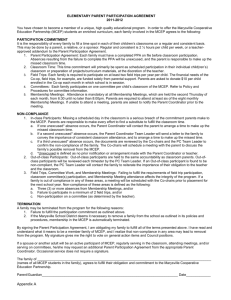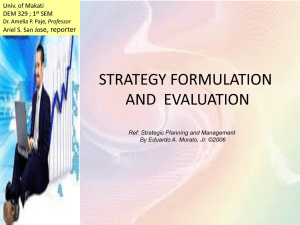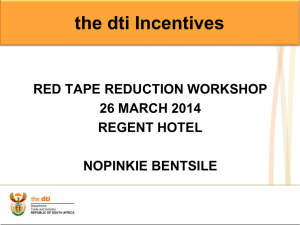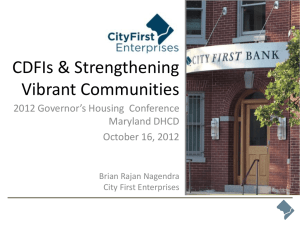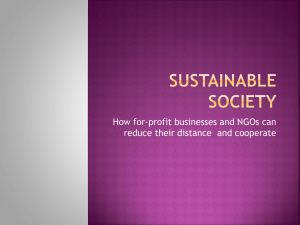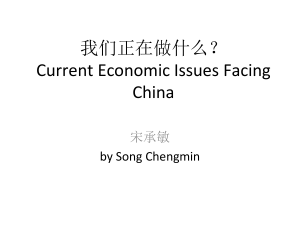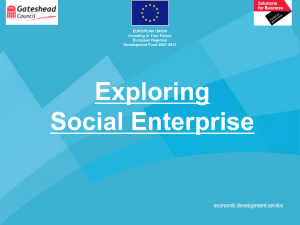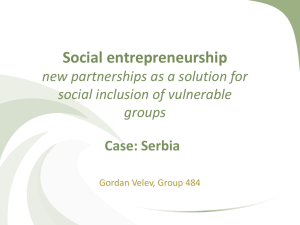MCEP
advertisement
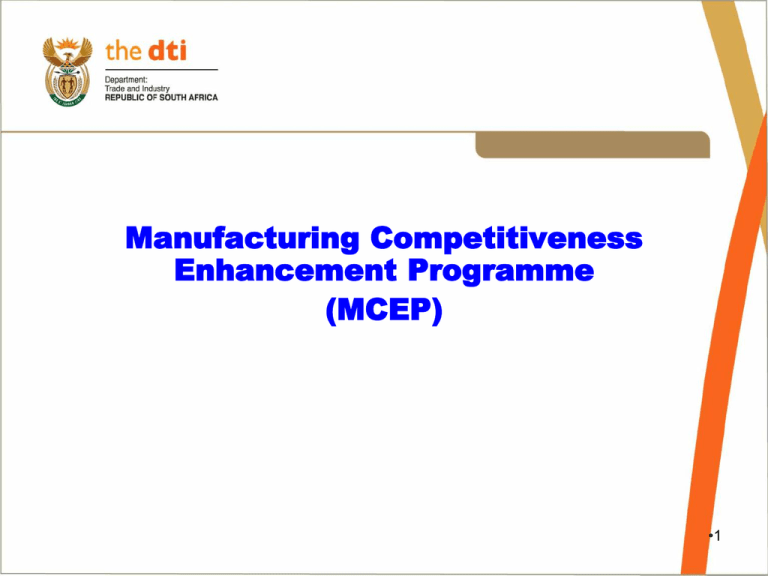
Manufacturing Competitiveness Enhancement Programme (MCEP) •1 Outline • • • • • • • • • • Objectives Key Principles MCEP Framework MVA Calculation Eligibility Criteria Transitional provisions MCEP Components Exclusions Budget Application Process 2 Objectives of MCEP • Encourage enterprises to upgrade their production facilities, processes, products and up-skill workers • Provide for upgrading of sectors in order to maximise output and employment • Expand existing IDC distressed funding facility to SMEs, and reduce cost of capital for distressed enterprises • Reduce the price of working capital for exporters and businesses participating in govt infrastructure programmes • Strengthen the responsiveness of available incentive schemes to the current economic challenges. 3 Key principles • Flexibility and customisation – MCEP matrix incentive operates as a single programme with one overarching budget – Budget can be shifted amongst components depending on uptake between and during financial years – “test the market” – Individual components have clear, rules-bound access criteria – However, criteria can be customised on a sectoral basis informed by market failures / constraints identified in CSPs. • Sector prioritisation – Labouri Intensity – Strategic linkages within value chains – Vulnerability tr4 MCEP Framework • Non-taxable grant calculated as a % of Manufacturing Value Added (MVA) and capped as follows: – 7% of MVA - enterprises larger than R200m in assets – 10% of MVA - enterprises with assets >R30m – <R200m – 12% of MVA - enterprises with assets between >R5m – <R30m – 15% of MVA – 100% black-owned enterprises and enterprises with assets below R5m • Available over a two year period • Grant more favourable to SMEs 5 MVA Calculation Sales/Turnover Less: Sales value of imported goods Less: Sales value of other Bought in Finished Goods Less: Material Input costs (Used in manufacturing process) = MVA 6 MCEP Components • Production Incentive (the dti: TEO) – – – – – Capital Investment Green Technology and Resource Efficiency Improvement Enterprise-Level Competitiveness Improvement Feasibility Studies Cluster Competitiveness Improvement • Loan Facilities (IDC) – Pre/post-dispatch Working Capital Facility; and – Distress Funding interest make-up facility – Niche Fund Facility 7 MCEP Eligibility Criteria • Manufacturing (SIC 3) conformity assessment agencies servicing the manufacturing sector. – Basic chemicals, Basic iron and steel, Manufacture of pulp and paper, Basic precious and non ferrous metals, Petroleum refineries and Processing of nuclear will be considered if projects create down stream jobs. • Employment: Projects are required to sustain existing employment levels at the date of application, for the duration of their participation in MCEP. The programme is designed to last for six years and enterprises are required to renew their participation at the end of every two years. • B-BBEE: Applicants should achieve at least a level four (4) B-BBEE contributor status, in terms of the codes of good practice or submit a plan to demonstrate how they will achieve level – 4 B-BBEE contributor status within a period of four (4) years. – Applicants who are unable to comply to the B-BBEE and employment criteria have to provide a motivation to the dti at the time of application. MCEP Eligibility Criteria • Submission of applications: Applicant/s must submit a complete application at least 60 calendar days prior to commencement of commercial use of the assets or undertaking activities being applied for. – the dti to adjudicate and respond within 60 calendar days after submission of a complete application – If the dti does not respond within the 60 calendar days after submission of a complete application, applicant should notify the dti in writing of its intention to commission the qualifying assets for commercial use or undertake implementation of business development activities before approval may proceed with the project before approval – The assets or activities will not be disqualified on the basis of having been in commercial use or being undertaken before approval Transitional Provisions • PI Capital Investment and Green Technology Upgrading grants with a start of production date falling on 30 May 2012 up to 30 July 2012. Such projects may lodge applications until the 31 August 2012 • MIP expansion Projects not in commercial production before the start date of MCEP on 04 June 2012 and have not claimed the grants under the MIP are eligible to apply • MIP application and/or agreement should be withdrawn or cancelled • Projects that have submitted MIP claims, cannot convert such approval or claims to the PI Capital Investment and Green Technology Upgrading grants • However, such projects may apply for other components of the MCEP MCEP (PI) Components • A Capital Investment grant : – A cost sharing grant towards investment in upgrading capital equipment and expansion of productive capacity. Cost sharing will be between 30, 40% and 50% of the investment with smaller enterprises receiving a larger percentage of their investment. Max grant R50m. – Minimum eligible projects: Small enterprises (assets below R5m) R500,000. – Enterprises with assets above R5m; capital investment of at least 20% of total assets – Additional 10% bonus grant for enterprises with assets above R5m, if the create new additional jobs or Procure at least 50% ‘in rand value’ of the total project budget in machinery and equipment and tooling manufactured in South Africa (SA). Enterprise size No. Of new additional jobs >R5 million – <R30 million >10 jobs >R30 million – <R200 million >20 jobs >R200 million >25 jobs 11 MCEP (PI) Components • Green Technology and Resource Efficiency Improvement grant: – A cost sharing grant towards investment in technology and process that will make the production process greener resulting in cleaner production and improved energy efficiency. Cost sharing will be between 30, 40% and 50% of the investment with smaller firms receiving a larger percentage of their investment. Max grant R50m. – Additional bonus grant also available for enterprises that create new additional jobs or procure machinery and equipment manufactures in SA • Enterprise-Level Competitiveness grant: – A cost sharing grant towards investment in the adoption of world class manufacturing practices such as lean production system, Six Sigma, etc, adoption and accreditation of conformity and quality standards such as ISO, the CE mark, improved packaging design, acquisition of IT software systems, project specific skills upgrading, etc. Cost sharing will be between 50 to 70% of project costs. 12 MCEP (PI) Components • Feasibility Studies grant: – A cost sharing grant towards developing a bankable feasibility study for new manufacturing projects. Qualifying costs will include engineering design costs, EIA costs and other relevant consulting fees. Cost sharing will be between 50 to 70% of project costs. • Cluster Interventions grant: – A cost sharing grant towards support for cluster initiatives to improve competitiveness, innovation and access to new markets. Examples of initiatives that can be funded include shared infrastructure such as a sector technology development centre, market research, international advertising and publicity costs, etc. Access will be subject to a defined minimum number of enterprises and cost sharing will be 80% of qualifying project costs. 13 Exclusions • Enterprises already receiving dedicated sector support such as those benefiting from the MIDP, APDP, AIS, the Clothing and Textile CTCIP are excluded. • An automotives manufacturer with less than 25% of its base-year turnover earned as part of motor manufacturers’ vehicle (light, medium or heavy) supply chain (including after-market supply) locally and/or internationally may be considered for eligibility under MCEP 14 Sector Examples SECTOR → Investment support Agro-processing Support for small scale maize milling Capital / Transport Investment in new Equipment equipment / technology to supply componentry into rapidly scaling up rail procurement programmes Renewables: Wind Investment in new and Solar equipment / technologies to implement existing capabilities (e.g. fabrication / casting, composites) to wind and solar component manufacture → Working capital → Project → Competitiveness → Competitiveness → Standards, Feasibility Studies upgrading - firm upgrading - sector Accreditation and level support level support Certification Pre-shipment finance for large orders, offered on terms comparable to those secured by import competitors Support to explore Support for product feasibility of development and industry canning commercialisation facility to combat in domestic and monopolistic tin and export markets packaging prices Market studies to Support for meeting identify processed SPS standards in food opportunity new markets into high growth, net food importing developing countries Feasibility studies into new capital projects linked to SA capital equipment supply base Support for technolgy / skills development e.g. NTI Support for 'lateral migration' of capabilities to wind and solar componentry Support to meet OEM standard and safety requirements Support for domestic manufacturers for SABS system testing of SWH systems. Support for new companies in wind and solar for certification that e.g. blades meet 15 OEM tolerance thresholds MCEP Budget Assumptions Total VA of sectors covered 2010 R'm 2012 2013 2014 2015 2016 113,431 10% of VA cap 11,343 % of VA covered Amount of incentive Actual MTEF allocation 2011 Total Total (20122017 (2012-2014) 2017) 11,910 12,506 15% 13,131 25% 13,788 14,477 15,201 15,961 30% 1,876 3,283 4,136 1.,250 2,000 2,500 20% 2,895 10% 1,520 5% 798 9,295 14,508 5,750 •Selected Sectors Cover: •44% of manufacturing Jobs •15% of fixed capital in manufacturing and •33% of manufacturing MVA 16 APPLICATION FORM 17 18 19 •20 21 22 23 24 25 THANK YOU 26 MCEP (Loan) Components • Pre/Post-dispatch Working Capital Facility: – Finance to cover working capital requirements from • Date of receipt of order to dispatch to customer; including raw material, packaging and transportation costs • Date of dispatch of goods to date when seller realises the proceeds of sale. Can include performance bonds and guarantees – Finance fixed at 6% • Distressed Concessionary Fund – Preferential interest rate facility for any distressed manufacturers – Finance fixed at 6% – No fees to be levied • Niche Funding – Strategic projects proposed by IDC and dti sector desk 27
